PRINCETON, NJ -- One in four American workers (24%) reported that their companies created jobs in May -- essentially the same as the 23% in the first four months of this year, but down 13 percentage points from a year ago. At the same time, job loss -- the percentage of workers saying their employers are downsizing -- eased slightly, to 26% from 28% in April, but remains 10 points higher than a year ago. While job loss is slowing, it still exceeds job creation, and Gallup's modeling suggests the U.S. unemployment rate is likely to reach or exceed 9% when the Labor Department reports it on Friday.
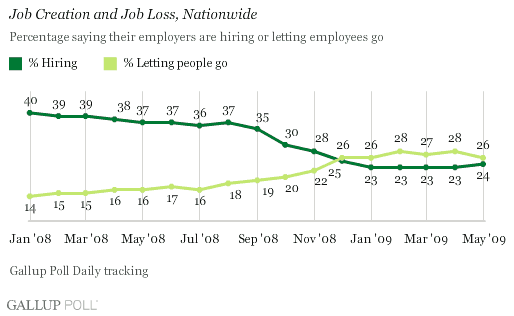
Job Creation/Job Loss by Region
Job creation remained highest in the South last month, continuing a pattern seen since January of last year. In May 2009, 26% of employees reported that their companies were hiring, while job loss (24%) remained the lowest of any region. Although the job situation in the South is essentially unchanged from April, it also represents a substantial deterioration from the 39% job creation and 15% job loss of a year ago. The South continues to benefit from the large presence of the energy industry and will show additional improvement going forward if oil prices continue to surge.
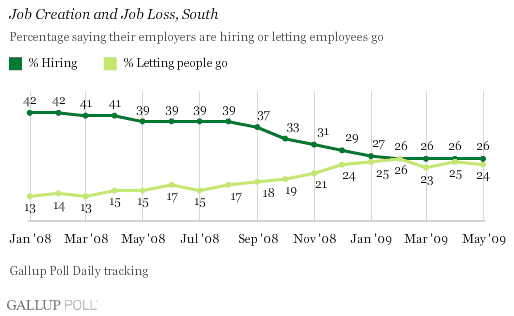
During May, job creation improved slightly in the East, to 25% -- up from 23% in April, but down 11 points from a year ago. Job loss also improved, to 27% from 30% in April. The stock market surge and the increased stabilization of the banking industry may be helping the job market in the East.
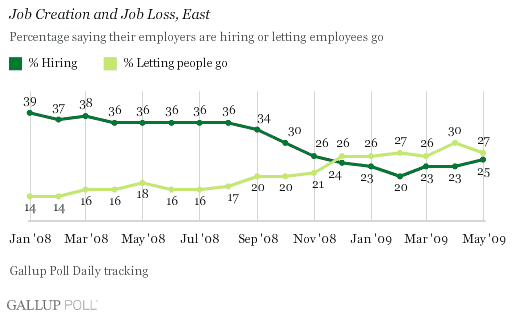
Job creation continues to be relatively anemic in the Midwest, at 22% -- the same as in April -- but job loss has eased by four points (from 29% to 25%) over the past two months. Of course, this situtation may change in the months ahead as the automaker bankruptcies take their toll on jobs in this part of the country.
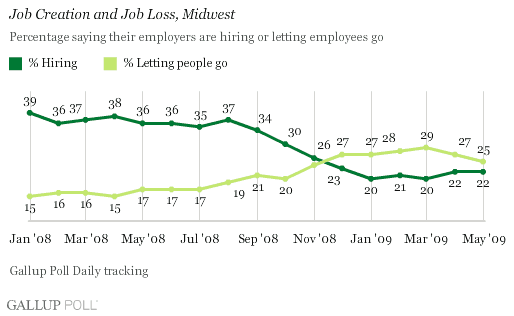
Job creation in the West recovered a little in May to 23% from its April low of 19% (which was also the low for any region over the past 17 months). At the same time, job loss eased somewhat, to 28% from 30% in April. However, even with these improvements, the job situation in the West continues to be the worst in the country. It seems as though the housing debacle continues to depress this region more than any other part of the country.
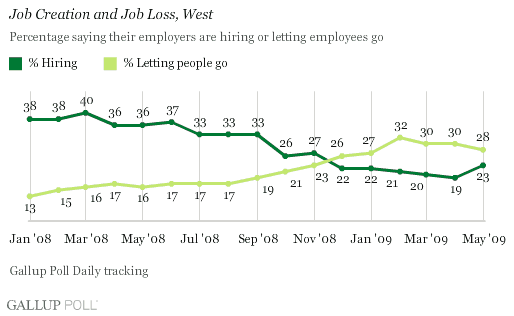
Commentary
Given the sharp improvement in the equities market and the , it may be that many employers are beginning to feel more comfortable with the size of their current work forces. They may also feel the need to be positioned to take advantage of any improvement in consumer spending spawned by this increased consumer optimism. Gallup's Net New Hiring Index tends to support this idea. So does the drop-off in layoff announcements reported by Challenger Gray & Christmas on Wednesday and the continued high, but not increasing, jobless claims that the Labor Department reported Thursday morning.
Still, employers don't seem ready to add to their work forces nor do entrepreneurs seem prepared to hire for new businesses given the overall lack of business visibility. In order to create more jobs, companies will want to actually see improvement in consumer spending -- not just an increase in optimism. Gallup's Monitor of Consumer Spending , nor is the government's retail sales report for April or Thursday's individual retailer sales reports for May.
As Gallup's job market results show, job creation and job loss are ongoing dynamics in a large, complex economy like that of the United States. The trick to achieving real economic growth is to make sure that job creation is taking place at a significantly greater rate than job loss. A year ago, there were more than two jobs being created in this nation for every one eliminated; now, more jobs are being eliminated than created. And, while the degree of job loss slowed a little last month, the persistent job losses mean the unemployment rate continues to increase at an intolerable rate. In fact, Gallup's Net New Hiring Index suggests Friday's unemployment rate not only is likely to hit 9% but could exceed it significantly.
Job creation is essential to getting consumers to increase their spending -- at least, to . In this regard, job creation -- not just job preservation -- should be an essential consideration as Washington decides how it will intervene in various aspects of the private-sector economy in the months ahead.
Survey Methods
Gallup's Net New Hiring Index for May is based on aggregated interviews with a nationally representative random sample of approximately 8,087 employed adults, aged 18 and older. For monthly results based on this sample, the maximum margin of sampling error is ±1 percentage point. The May regional results are based on samples of between 1,759 and 2,422 employed adults, with a maximum margin of error of ±3 points.
Interviews are conducted with respondents on land-line telephones (for respondents with a land-line telephone) and cellular phones (for respondents who are cell-phone only).
In addition to sampling error, question wording and practical difficulties in conducting surveys can introduce error or bias into the findings of public opinion polls.
